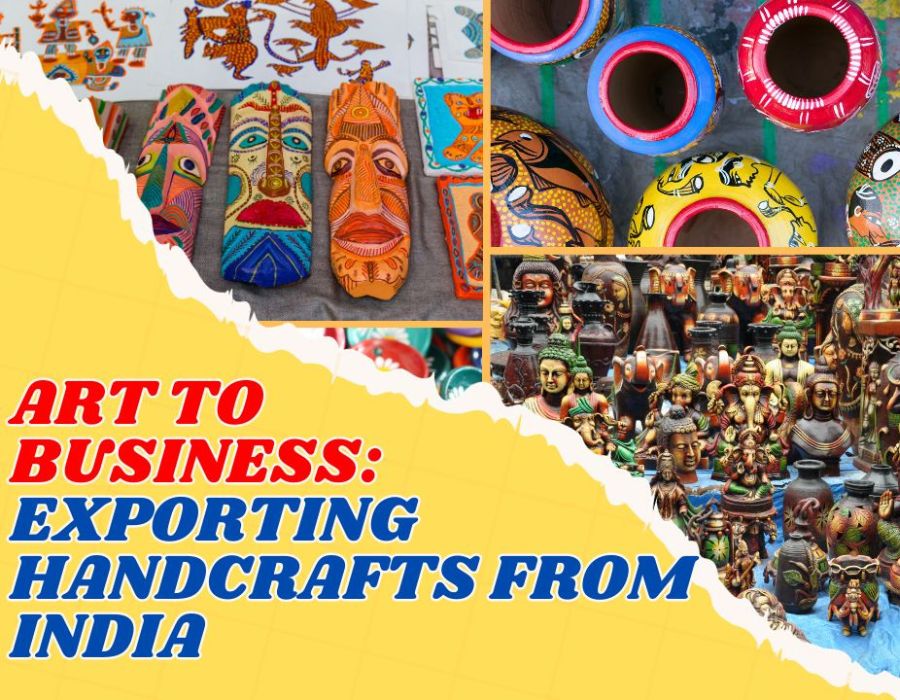The global trend towards artisanal and eco-friendly goods has made it more important than ever to export handicrafts from India, and Indian handicrafts are well positioned to benefit from this transition.
Indian handicrafts have a timeless appeal that cuts across national boundaries, and they are a dynamic representation of the nation's rich heritage and cultural variety. The elaborate craftsmanship, varied materials, and distinctive methods used in their production strike a deep chord with customers throughout the world who are looking for products that are genuine and sustainable.
As the world market is becoming more accessible through digital channels, Indian artisans and traders have the unprecedented opportunity to showcase their crafts to a wider audience, thus opening new avenues of economic growth and cross-cultural exchange.
The impact of export import data of these treasures goes far beyond mere commerce; it is a celebration of Indian culture on the world stage. Economically, the export of handicrafts significantly contributes to the livelihoods of artisans and the overall GDP of India, supporting numerous small and medium enterprises across the country.
From a cultural standpoint, these exports represent Indian customs; each piece tells a tale of the history, spirituality, and aesthetic sensibility of the region. Therefore, Handicrafts Export from India helps to preserve India's artisanal heritage in the fabric of global culture while also satisfying the world's desire for unique and meaningful goods.
India's Handicraft Exporters and Handicraft Exports from India
The Federation of Indian Export Organizations (FIEO) reported that India's handicraft exports increased by 8.4% in 2017–18 to reach Rs. 34,122 crores. India is one of the world's top exporters of handicrafts, with 2.36% of its total export revenue coming from this sector of the economy. India's top ten export destinations for handicrafts are the US, UK, Germany, UAE, Spain, Italy, France, Belgium, Luxembourg, Japan, and Switzerland.
In India, the handicrafts industry employs around 4 million craftspeople. Many people who are below the poverty line find employment in this business, which is crucial to their means of subsistence.
The Indian government offers a number of programs and projects aimed at advancing and growing the nation's handicraft industry. Among these are the National Mission on Handicrafts (NMH), the Handicrafts Mega Cluster Scheme (HMCS), the Preferential Market Access Scheme (PMA), the Interest Subvention Scheme (ISS), and the Marketing & Exhibition Assistance Scheme (MEAS).
Anokhi Adajania Handicraft Exports Pvt Ltd., Jaipur Rugs Company Pvt Ltd., The Bombay Store Pvt Ltd., and Sunita Handicraft Exports are a few of the top Indian exporters of handicrafts.
The Most Popular Export of Indian Handicrafts
- Indian Home Decoratives
- Handmade Sarees, other hand made products
- Home furnishings, linens, and kitchenware
- Precious gems and jewelry
- Imitation jewelry
All these items are most demanded on an international platform.
Top Handicrafts Manufacturing States
- Saharanpur – Woodworks
- Assam – Terracotta works
- Gujarat -Textile handicrafts and fabrics
- South India – Coconut craft, Mask making, Silk weaving
- Kashmir – Woolen Handicrafts
- Rajasthan – Gems, Precious Stones, Jewellery, Leather, Paintings, Silver, Brass
Some of the Top Handicraft Exporter of India are:
Getting Funded for Your Craft: Investing Opportunities for Indian Handicraft Exports
Understanding the costs associated with exporting handicrafts.
A vital first step for companies and artisans wishing to export Indian handicrafts is navigating the financial environment. Pricing items competitively in the global market requires a thorough grasp of the expenses associated with marketing, production, shipping, and other overheads.
In addition, making use of the export subsidies and incentives offered by the Indian government can greatly lower costs and increase revenue. These incentives, which could include advantages like duty-drawback programs, tax breaks, and subsidized credit facilities, are intended to promote Indian crafts internationally.
Government subsidies and export incentives for Indian handicrafts.
Securing the financial aspects also involves negotiating favorable payment terms with international buyers, such as letter of credit or advance payment, to ensure there is minimal risk of non-payment.
The top Indian buyers of handicrafts are listed below.
- The United States of America is a significant consumer of Indian handicrafts, including shawls, Zari wood, embroidery goods, imitation jewellery, and hand-printed fabrics.
- The United Kingdom purchases art goods, crocheted products, handcrafted wooden goods, imitation jewellery, and handmade handicrafts from India.
- Germany is commonly known for the purchase of hand-printed textiles, Imitation jewellery, Embroidery items, and Art metals.
The Indian government and the private sector have adopted a number of initiatives to support and grow the export of Indian handicrafts. India's handicrafts are developed and promoted through a number of schemes under the National Handicraft Development Programme (NHDP).
Thus, the expansion of handcraft exports from India offers a market for the handicraft sector, which has the potential to expand rapidly on a global scale.
Conclusion
Upon contemplation of the complex fabric of exporting Indian handicrafts, we perceive a painting that Seair Exim Solutions, being a seasoned Import-Export consultant, has contributed to illustrating with sustainability and success. They are prepared to assist new exporters who are starting down this exciting path by providing them with practical advice as well as words of encouragement.
These cultural entrepreneurs have the resources necessary to successfully negotiate the challenging international waters thanks to Seair Exim Solutions' profound comprehension of the subtleties and strategic aspects of the market. Their advice is essential for developing a profitable business plan as well as for making sure that each distinctive work embodies the spirit of India's rich legacy, creating a lasting influence on the world.






Comments